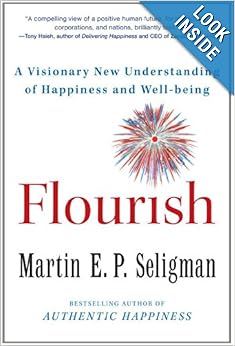
In Flourish: A Visionary New Understanding of Happiness and Well-being, Martin Seligman, a psychologist and one of the
pioneers in the field of positive psychology, builds on (and explains the
weaknesses of) his work on “authentic happiness theory,” refining it into what
he calls well-being theory. Seligman
writes, “I used to think that the topic of positive psychology was happiness,
that the gold standard for measuring happiness was life satisfaction, and that
the goal of positive psychology was to increase life satisfaction. I now think
that the topic of positive psychology is well-being, that the gold standard for
measuring well-being is flourishing, and that the goal of positive psychology
is to increase flourishing.”
In Flourish,
Seligman adds two more elements (Relationships and Achievement) to the three
elements already named in authentic happiness theory (remember them by using
the mnemonic PERMA):
- Positive emotion (of which happiness and life satisfaction are all aspects)
- Engagement (flow)
- Relationships
- Meaning
- Achievement
Each of these elements contributes to well-being without
defining it. Some are measured
subjectively and others are measured objectively. Seligman added these
additional dimensions because he feels that “life satisfaction holds too privileged
a place in the measure of happiness” because “how much life satisfaction people
report is itself determined by how good we feel
at the very moment we are asked the question.” Many people who lack a natural
cheerfulness may have more engagement and meaning in their lives than those who
are more outwardly “happy.”
Flourish is an
interesting book, and though it’s more theory than practical application, it
does contain some interactive exercises (I mentioned one of them here). The
book also contains a bit of history of positive psychology and Seligman’s
career, as well as a defense of positive psychology against critics.
What I took from the book was the idea that well-being was a
broader, richer concept than simple “happiness,” and that you can have
well-being without constantly feeling cheerful or “happy.” I don’t believe it’s
possible—or even desirable—to feel happy all the time. I do, however, feel that
pursing the elements of PERMA will help you build a more deeply satisfying—and,
yes, happier—life.




.jpg)


